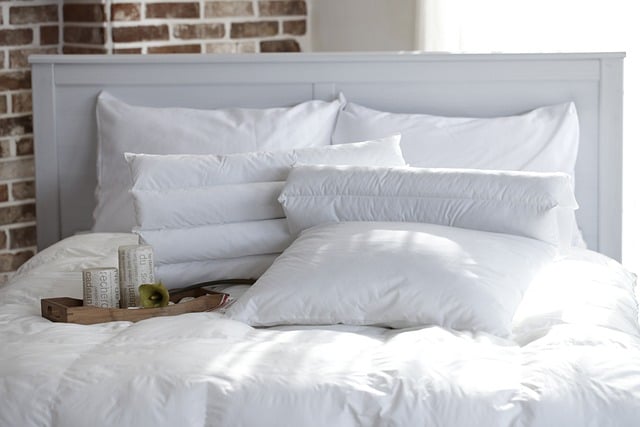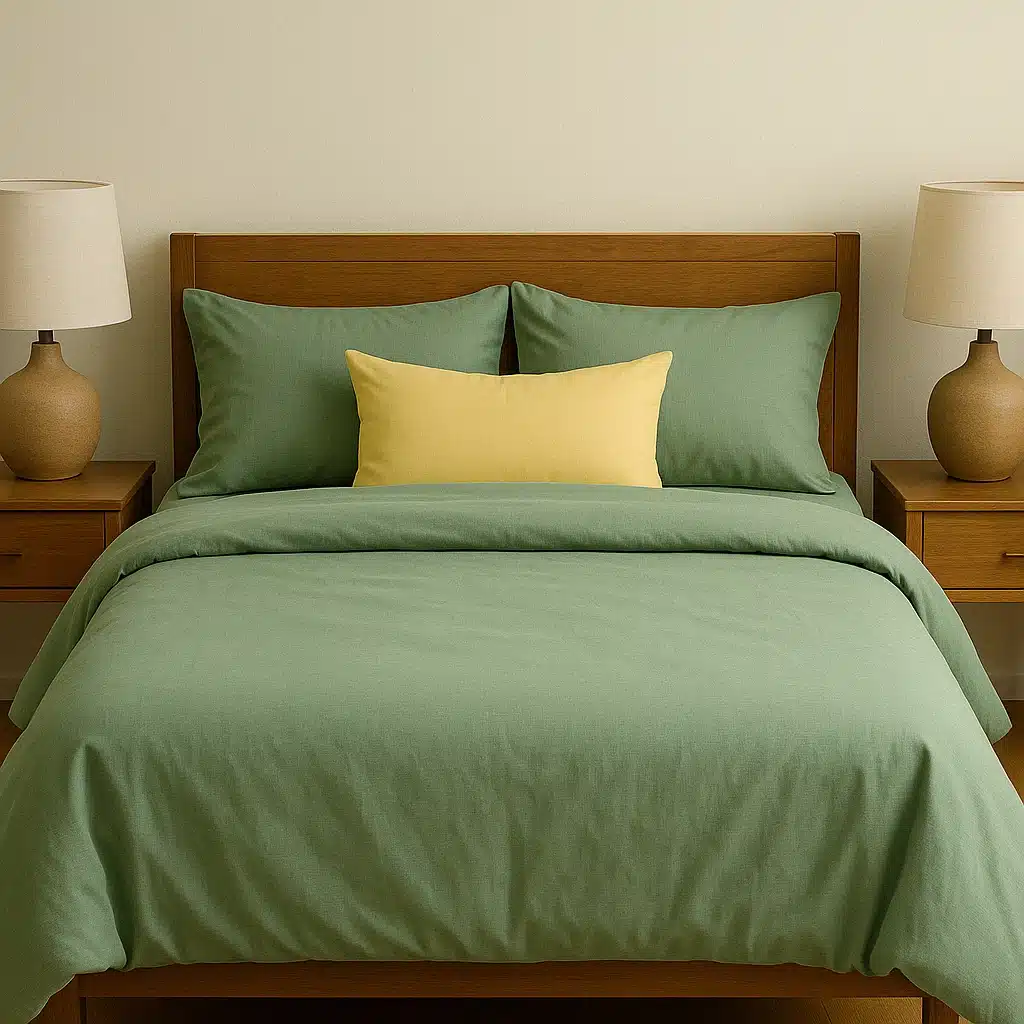You’ve probably seen “sustainable bamboo bedding” mentioned as a greener alternative—but how eco-friendly is it, really? Bamboo grows fast and doesn’t need much water or pesticides, which sounds great. But not all bamboo bedding is made the same way.
Some options live up to the promise, while others fall short. If you’re trying to make better choices for your home and the planet, this guide will help you understand what to look for, what to avoid, and whether sustainable bamboo bedding truly fits your eco lifestyle. For more details, check out my guide to eco-friendly bamboo sheets.
Covered Below
Why Sustainable Bamboo Bedding Gets So Much Eco Praise
Bamboo grows quickly, doesn’t need much to thrive, and comes back again and again without replanting. That alone gives it a big edge over crops like cotton. Plus, it grows without the heavy use of pesticides or fertilizers.
One more bonus? Bamboo is known to release more oxygen and pull in more carbon dioxide compared to many types of trees. It pulls its weight when it comes to improving air quality.
Why It’s So Comfortable
Aside from being greener than most fabrics, bamboo bedding feels good. The fibers are smooth and naturally gentle, which is great if you have sensitive skin or allergies. Here’s why bamboo sheets work so well for sensitive skin. It also helps wick away moisture, so your body stays at a comfortable temperature, even when the seasons change.
Want even more comfort? Pair your sheets with cooling bamboo pillowcases for a fresher night’s sleep.
Bamboo and Carbon Absorption
This is where bamboo really shines. Some studies suggest it absorbs more CO2 than many other plants, especially fast-growing species. That makes it a strong ally in lowering greenhouse gas levels. The more bamboo that’s grown and managed properly, the better it supports a low-carbon lifestyle.

What’s the Catch? Fabric Processing
Bamboo might be sustainable in the field, but turning it into fabric is a different story. Most bamboo sheets are made through the viscose process, which uses harsh chemicals like caustic soda to break the plant down into a soft fiber.
While effective, this method can be hard on the environment—especially if the chemicals aren’t captured or recycled properly.
A Better Option: Lyocell (Closed-Loop) Processing
Some companies now use lyocell methods, which involve fewer chemicals and keep most of them contained in a closed-loop system. That means less waste and less pollution.
It’s still not the norm, and most bamboo bedding on the market is still made with viscose. But if you want the most sustainable bamboo bedding, it’s worth checking if the brand uses this cleaner process.
You can learn more about the differences in my post on how bamboo fabric is made.
Bamboo Farming and Land Use
Bamboo farming usually doesn’t need pesticides or a ton of water. But that doesn’t mean it’s perfect. In some areas, forests have been cleared to make room for bamboo plantations, which can reduce biodiversity.
Compared to cotton though? It’s still a gentler option. Cotton uses massive amounts of water and takes up 16% of the world’s insecticide use. Bamboo has a smaller footprint overall, but large-scale monoculture farming of anything can affect soil and local wildlife.
What About the Shipping Impact?
Most bamboo bedding is made in Asia and shipped overseas. That long trip adds to its carbon footprint. But honestly, that’s also true for most cotton and synthetic bedding unless it’s made locally.
If you’re trying to reduce overall impact, look for brands that ship efficiently or offset their transport emissions.
Bamboo vs Other Bedding Materials
Here’s how bamboo stacks up:
| Material | Water Needs | Pesticide Use | Biodegradable |
|---|---|---|---|
| Bamboo | Low | Minimal | Yes |
| Cotton | High | High | Yes |
| Polyester | Moderate | None | No |
Bamboo comes out ahead in most of the big categories, especially when you consider water use and biodegradability.
What About the Price?
Sustainable bamboo bedding can cost more than standard sheets, especially if it’s made with eco-friendly processing and comes with certifications. But for many people, the benefits—like better comfort, fewer allergens, and longer lifespan—make the extra cost worth it.
If you’re on a budget, look for sales or bundles from transparent brands. A slightly higher upfront price often means you won’t need to replace your sheets as often.
How to Care for Your Bamboo Bedding
Want to keep your bedding comfy and long-lasting?
- Wash on a gentle cycle: Stick with cold water to protect the fibers.
- Dry with care: Line drying is best, but if needed, tumble dry using low heat.
- Store well: Keep it in a dry, cool spot so it doesn’t lose freshness. And avoid using fabric softeners or bleach—they can wear down the fibers and shorten the lifespan.
Want to go full eco-mode? Pair your sheets with one of these eco-friendly bamboo comforters.
How to Tell If Your Bamboo Bedding Is Truly Sustainable
Not all bamboo bedding is made the same way. Some products truly support sustainability, while others are just dressed up in clever marketing. Here’s how you can tell the difference.
🛒 Quick Tips When Shopping for Bamboo Bedding:
- Look for terms like “bamboo lyocell” or “closed-loop rayon”
- Skip brands that use vague buzzwords like “natural luxury” without specifics
- Scan reviews—see if people mention how the sheets feel after a few washes
Watch out for greenwashing: Some brands throw around words like “natural luxury” or “eco-soft” without saying how the fabric is actually made. If there’s no info on sourcing or processing, it might just be clever marketing.
What to Look For:
- Certifications: Labels like OEKO-TEX or GREENGUARD help confirm the bedding meets safety and environmental standards.
- Transparent Brands: Brands that clearly explain how their fabric is sourced and processed are usually more trustworthy.
- Processing Method: Lyocell or closed-loop viscose is a greener sign.
Frequently Asked Questions About Bamboo Bedding and Sustainability
- Is bamboo bedding really sustainable? It can be, especially if it’s made with closed-loop or lyocell processing and comes from a responsible brand.
- How can I avoid greenwashing? Skip vague labels like “eco-luxury” and look for real info about sourcing, processing, and certifications.
- Is bamboo better than cotton? In terms of water use, chemicals, and biodegradability, bamboo usually has the edge—but only if it’s produced sustainably.
- What is the downside to bamboo sheets? Some bamboo bedding is made using harsh chemicals through the viscose process. If that process isn’t done responsibly, it can harm the environment. Some people also notice they wrinkle more easily than cotton.
- Is 100% viscose from bamboo the same as 100% bamboo? Not exactly. “100% viscose from bamboo” means the fabric was made using bamboo as the raw material but processed with chemicals to turn it into soft fiber. It’s different from natural bamboo fabric.
- What is the most sustainable bedding material? It depends on how it’s made. Bamboo lyocell, organic cotton, linen, and eucalyptus Tencel are all good options when processed responsibly. Bamboo lyocell is one of the best for combining comfort with lower impact.
- Which is better, Tencel or bamboo sheets? Both are soft and breathable. Tencel often uses a closed-loop process, so it may be more eco-friendly than viscose-based bamboo sheets. But bamboo lyocell and Tencel are pretty equal in sustainability when done right.
- Why do my bamboo sheets smell? New bamboo sheets might have a light odor due to packaging or processing. Washing them before use usually gets rid of the smell.
The Future of Sustainable Bamboo Bedding
As demand for eco-friendly products grows, more brands are working to improve how bamboo bedding is made. Cleaner production methods, better transparency, and innovations in fabric processing are slowly becoming more common.
If more shoppers keep asking the right questions and choosing brands that prioritize sustainability, bamboo bedding could become even greener in the years ahead.
Final Thoughts: Is Sustainable Bamboo Bedding the Right Choice?
Sustainable bamboo bedding can be a great fit if you care about comfort, skin health, and the planet. But not all products are created equally. Look beyond the label, check the process, and choose brands that are honest about what they’re doing. Choosing the right sustainable bamboo bedding makes a real difference—both for your comfort and the environment.
Making small swaps like this adds up—especially when you’re building a greener home.
Ready to make the switch? Explore my top picks for eco-friendly bamboo sheets to find one that fits your lifestyle and your values.

